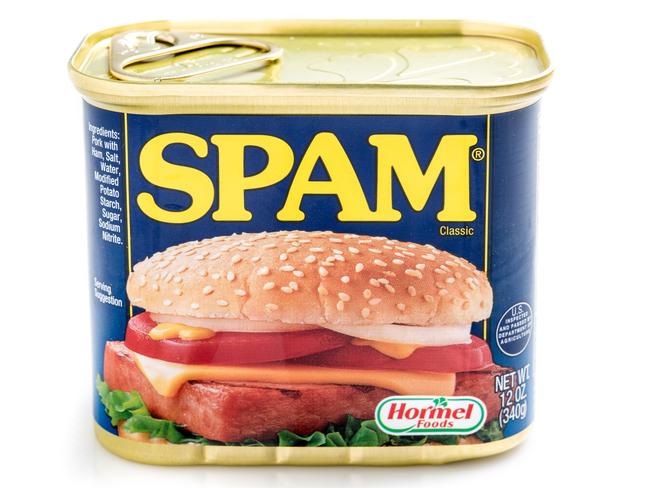People shocked to learn what SPAM actually stands for after decades
Foodies have had their world turned upside down after learning what the acronym SPAM – referring to the infamous canned pork – actually stands for.
Eat
Don't miss out on the headlines from Eat. Followed categories will be added to My News.
No, it doesn’t stand for junk mail.
It’s not just tomato sauce preservation methods that are blowing people’s minds online. Foodies have had their world turned upside down after they learned just what the acronym SPAM – referring to the ubiquitous, canned pork patty – stands for.
First released in 1937 by Minnesota-based food firm Hormel Foods, the infamous meat rectangle has become synonymous in culinary circles with the ultimate mystery meat, the New York Post reports.
Fortunately, the ingredients of the product are not an enigma: they entail a rather simple (especially in today’s additive-saturated supermarket aisles) assemblage of pork, water, salt, potato starch, sugar and sodium nitrate.
However, the acronym has continued to frazzle minds, with food-unsavvy social media users conjuring up their own theories for what the letters represent.

“On a whim I purchased canned meat,” one said. “With the first taste I understood SPAM was an acronym for Salt Preserves Any Meat.”
“What does SPAM stand for? Salty Piece A’Meat?” theorised another.
“I often conjectured that ‘Spam’ was an acronym for ‘Spoiled Ham’,” another said, while someone else wrote, “I just learned that SPAM is an acronym for Sizzle Pork And Mmm.”
On a whim I purchased canned meat. With the first taste I understood SPAM was an acronym for Salt Preserves Any Meat.
— ⛲ Susan ⛲ (@onascaleof1210) January 24, 2021
What does SPAM stand for? Salty Piece A' Meat?
— NavajoRezKid (@YDLCristoll) October 24, 2022
I often conjectured that 'Spam' was an acronym for 'Spoiled Ham'.
— Howard Miller (@HowardeMiller) June 19, 2023
I just learned that SPAM is an acronym for Sizzle Pork And Mmm
— Nikki Wallschlaeger (@nikkimwalls) July 30, 2021
Others invoked the old Bill Engvall joke that SPAM stands for “stuff posing as meat”.
Other pervasive misconceptions included “scientifically processed animal matter” and “shoulder of pork and ham”.
Some flabbergasted commenters weren’t aware that SPAM stood for anything.
“I was today years old when I learned that SPAM is an acronym,” one said.


As it turns out, they’re all wrong. SPAM is actually a portmanteau of “spiced ham” that actor Ken Daigneau, the brother of a Hormel executive, dreamt up during a naming contest, Time reported.
Daigneau spit out “Spam” as if “it were nothing at all”, company founder Jay Hormel told New Yorker writer Brendan Gill in 1945, according to Eater. “I knew then and there that the name was perfect.”

SPAM hit shelves on July 5, 1937, helping fill the much-needed cheap eats void created during the Great Depression, per the Hormel Foods website.
Its popularity skyrocketed during WWII due to its seemingly endless shelf life, which allowed the pork to be shipped anywhere in the world. SPAM is now available in 44 different countries.
Originally devised as an affordable canned food, this upwardly mobile block of meat has since been baptised into haute cuisine.
The culinary hipsterisation hit New York City with the arrival of Hawaiian and Japanese-inflected dishes such as SPAM fried rice with seared ahi tuna at Sushi Ko in 2014.
This article originally appeared on the New York Post and was reproduced with permission
Originally published as People shocked to learn what SPAM actually stands for after decades




